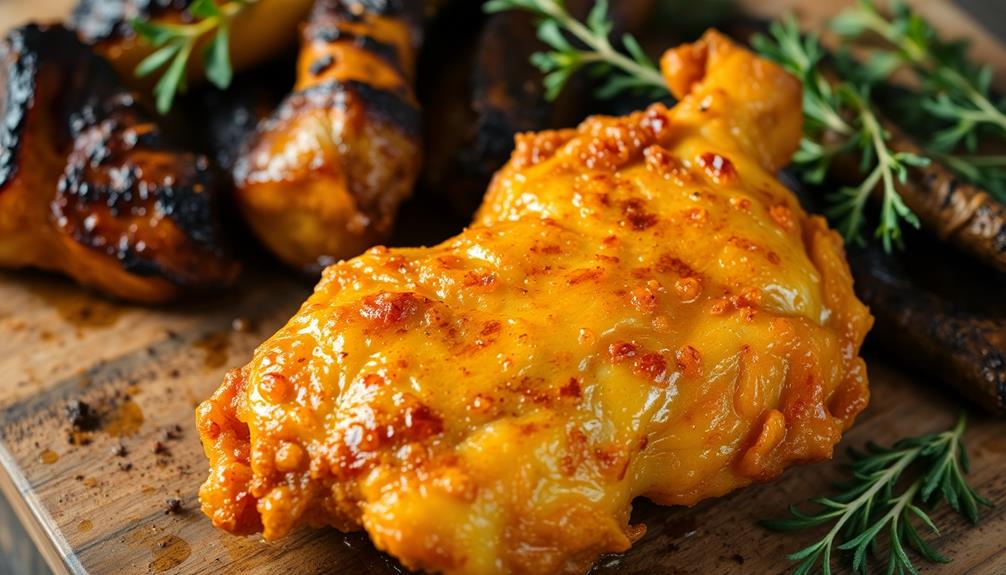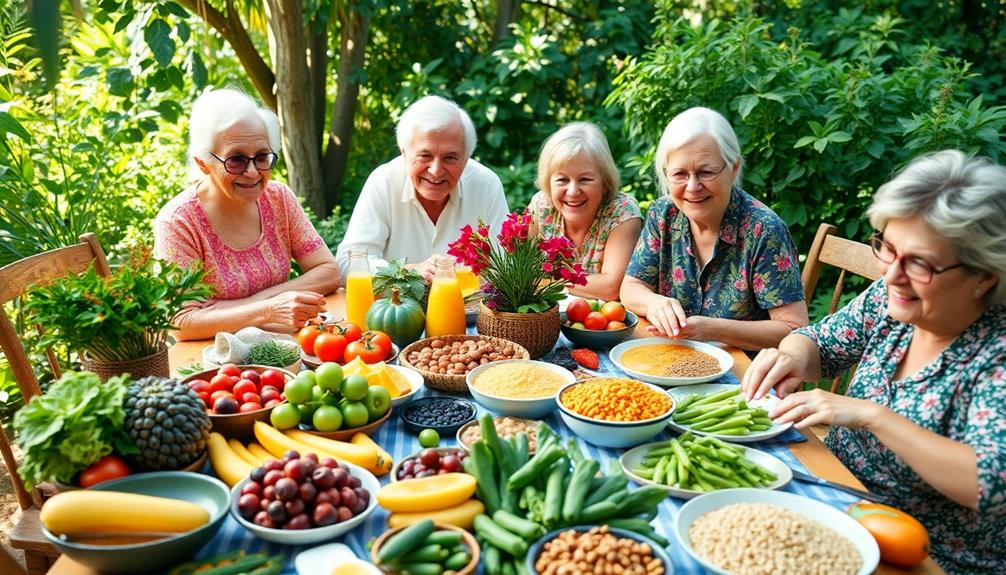To achieve perfectly crispy food textures, you need to focus on moisture management and high-heat cooking. Keep water levels low during preparation to prevent sogginess and use techniques like pre-roasting or frying for rapid moisture evaporation. The Maillard reaction enhances both flavor and golden-brown color, making your dishes more appealing. Incorporating ingredients like Panko breadcrumbs and using oils with high smoke points can also elevate the crispiness. Pairing crispy elements with creamy textures can enhance your meal experience. Discovering more about the science of achieving that perfect crunch could elevate your cooking to new heights.
Key Takeaways
- Proper moisture management is crucial; excess water leads to sogginess, while lower moisture enhances crispiness in food textures.
- High-heat cooking methods, such as frying and baking, promote the Maillard reaction, developing flavor complexity and desirable golden-brown colors.
- Using ingredients like Panko breadcrumbs and starches creates light coatings that absorb moisture, resulting in a crispier finish.
- Combining crispy elements with creamy components can enhance the overall dining experience by providing textural contrasts.
- Cultural preferences play a significant role in texture appreciation, with crispy foods often linked to shared dining experiences and positive emotional responses.
Understanding Food Textures
Food textures play an essential role in how you experience flavor and satisfaction during a meal. Understanding the differences between textures like crispy, crunchy, and chewy can greatly enhance your eating experience. For instance, Mexican dishes often showcase diverse textures; the crunchy tortilla chips in chilaquiles provide a delightful contrast to the creamy salsa and cheese.
Crispy foods fracture easily and produce a high-pitched sound, while crunchy foods undergo multiple fractures, creating a satisfying low-pitched crunch. To achieve that ideal crispy texture, you need to manage moisture levels carefully. High water content can lead to chewy or soggy outcomes, so proper drying methods are vital for foods like chips and fried items.
This is where the Maillard reaction comes into play. This chemical reaction not only enhances flavor complexity but also gives your food that appealing golden-brown color, making it visually enticing.
Cultural preferences also affect how we perceive food textures. While some cuisines lean toward chewiness, like mochi in East Asia, others celebrate crunchiness, such as crispy fried chicken in Southern U.S. cuisine. Recognizing these textures can deepen your appreciation for different dishes and elevate your overall culinary experience.
The Appeal of Crispiness
Crispiness captivates the senses, drawing you in with its unique combination of sound and texture. When you bite into a crispy food, the satisfying snap resonates, enhancing your overall experience. It's not just about the flavor; the texture is key in how you perceive and enjoy your meals.
For instance, consider the appeal of foods like onion rings or fried chicken, where the crunch adds an extra layer of enjoyment. Here are three reasons why crispy and crunchy textures are so appealing:
- Sensory Satisfaction: The sound produced when you crunch into crispy foods creates a pleasurable response in the brain, making you crave that experience again and again.
- Flavor Enhancement: The Maillard reaction that occurs during cooking adds complexity to flavor, making crispy foods even more irresistible.
- Cultural Significance: Many cuisines highlight the contrast between crispy and softer textures, elevating the dish's overall enjoyment and making it a staple in culinary practices.
Whether it's a fresh apple's wet-crispy bite or the crunch of a potato chip, crispy foods trigger delightful sensations. You can't help but love the way these textures bring your dishes to life, making every meal feel special.
Techniques for Achieving Crispiness
To achieve that satisfying crispiness in your favorite dishes, you need to master a few key techniques. First, focus on moisture content. Ingredients can tolerate varying levels of water, so it's essential to adjust accordingly to prevent sogginess. For instance, dishes like Red-Braised Pork Belly require careful moisture management to maintain their rich flavor while achieving the perfect texture.
The Maillard reaction plays a significant role here; by cooking at high heat, you'll develop that golden-brown color and complex flavors that define crispy texture.
Managing water activity is another important aspect. Aim for lower water activity to maintain crispiness, as higher levels can lead to chewy or soggy results. Techniques like pre-roasting help promote moisture evaporation, enhancing the overall crispiness of your dish.
When frying, consider using authentic Panko instead of standard breading. Its light and airy structure not only improves yield but also guarantees longer-lasting crispiness.
Finally, don't forget about fat content. Properly rendered fat, especially in foods like chicken skin, can aid in moisture release, further contributing to that delightful crunch.
Cooking Methods and Textures
Achieving the right texture in your dishes often hinges on the cooking method you choose. Different techniques can create a variety of textures, influencing how crispy or moist your food turns out.
For instance, dishes like Kue Putu (Bamboo Rice Cake) showcase how steaming can produce a tender yet slightly chewy texture, which contrasts beautifully with crispy fried items.
Here are three key cooking methods to reflect upon:
- Frying: This method excels at creating a crispy exterior due to rapid moisture evaporation and high heat. The Maillard reaction occurs here, adding flavor and color.
- Baking: While it can yield crispy results, successful baking requires careful attention to moisture content. Pre-roasting or par-cooking ingredients can enhance crispiness by reducing moisture.
- Grilling: High heat from direct flames can create a desirable char and texture, but timing and temperature are vital for preventing drying out.
Recipes for Crispy Delights
To create crispy delights, you need to focus on essential ingredients and effective cooking techniques.
Incorporating local flavors and ingredients, such as cassava, can add a unique texture to your crispy creations.
By minimizing moisture and choosing the right coatings, like Japanese Panko, you'll achieve that perfect crunch.
Plus, combining different textures in your dishes can elevate your meals and make them truly unforgettable.
Essential Ingredients for Crispiness
When it comes to creating perfectly crispy delights, the right ingredients play a significant role. Mastering moisture control, fat utilization, and cooking temperature is fundamental for achieving that coveted crunch. For instance, incorporating ingredients like Agnolotti can add a delightful contrast of textures to your dish.
Here are three key ingredients to take into account:
- Panko Breadcrumbs: Their light, airy texture drains oil better than standard breadcrumbs, enhancing crispiness while reducing greasiness.
- High-Quality Oils: Oils with high smoke points, like peanut or canola oil, guarantee effective heat transfer and moisture evaporation, which are essential for a crispy texture.
- Starches: Cornstarch or potato starch can create a dry coating that absorbs moisture, promoting crispness while frying.
By focusing on moisture control, you'll prevent chewy textures that detract from the experience.
Fat utilization is crucial, as it helps render flavors and crisp the exterior without sogginess. Finally, cooking at high temperatures facilitates the Maillard reaction, enhancing flavor and texture.
When you pair ingredients thoughtfully, like a crunchy coating with a creamy filling, you'll elevate your dish and delight your taste buds.
Keep these fundamental ingredients in mind, and you'll be on your way to crispy perfection!
Cooking Techniques for Crispiness
While you might think that crispiness is purely about the ingredients, the cooking techniques you choose can make all the difference. To achieve that delightful crunch, focus on reducing moisture, breaking down connective tissue, and managing fat content.
Frying is one of the best cooking techniques for crispiness, as it evaporates moisture rapidly, resulting in a satisfying texture. For instance, when preparing Squash Casserole, confirming the squash is well-drained before combining with cheese and breadcrumbs can greatly enhance the final crispiness.
Consider using authentic Panko breadcrumbs for a lighter, airier coating that drains oil better than regular breadcrumbs, leading to a less greasy finish. The Maillard reaction plays a vital role here, as it not only enhances flavor complexity but also contributes to that sought-after crunch during high-heat cooking.
Don't overlook the benefits of pre-roasting or par-cooking your ingredients before frying. This technique helps render fat and further reduce moisture, setting the stage for an even more satisfying crunch.
Combining Textures in Dishes
Texture plays an essential role in creating memorable dishes, and combining crispy elements with other sensations can elevate your culinary creations.
For instance, crispy elements can be paired with soft and creamy components to enhance flavors and provide a delightful eating experience. By experimenting with various textures, you can enhance flavors and provide a delightful eating experience.
Here are three delicious ideas to inspire you:
- Crispy Prosciutto Crostini: Pair crispy prosciutto with creamy spreads like goat cheese or avocado. The contrast of the crunchy and creamy textures creates a sensational bite.
- Chewy Macarons with Velvety Ganache: These French treats not only shine with their crispy outer shell but also surprise you with a chewy inside. The velvety ganache filling adds an indulgent layer, making each bite unforgettable.
- Panko-Crusted Fried Chicken: Using authentic Panko breadcrumbs enhances the crispy texture while frying. This technique not only gives your chicken a satisfying crunch but also improves visual appeal.
You might also consider incorporating dishes like Dorayaki to explore the delightful contrast of textures in sweets.
Cultural Significance of Crispy Foods
Crispy foods hold a special place in cultures around the world, often bringing people together over shared dining experiences. The cultural significance of crispy textures goes beyond mere flavor; it's about the pleasure derived from the crunch.
For instance, Thai street food features crispy delights like Sai Oua that highlight local flavors, showcasing how cultural preferences shape our dining experiences. Studies show that many people value the enjoyment of crispy textures even more than taste, emphasizing their importance in various culinary practices.
In East and Southeast Asian cuisines, dishes like mochi and crispy spring rolls highlight a deep appreciation for contrasting textures, showcasing how cultural preferences shape our dining experiences.
Similarly, the British classic of beans on toast and French onion soup reveals how crispy elements elevate meals, creating a satisfying mouthfeel that enhances overall enjoyment.
Crispy foods are often associated with freshness and quality, leading to positive emotional responses during social dining occasions. This explains the global popularity of snacks like potato chips and fried chicken, as they provide satisfying auditory and tactile sensations while being shared among friends and family.
Ultimately, the cultural significance of crispy foods lies in their ability to create connections and memories, reminding us that food is more than just sustenance; it's a celebration of shared experiences.
Frequently Asked Questions
What Is the Science Behind Crispy Food?
The science behind crispy food lies in heat application, which reduces moisture, triggering the Maillard reaction for flavor development. You'll achieve that satisfying crunch by using high temperatures and proper cooking techniques to enhance texture.
What Is the Science Behind Food Texture?
Food texture involves understanding how moisture affects ingredients, how cooking methods transform them, and how they respond to heat. You'll find that these elements combine to create the delightful sensations you experience while eating.
Why Do People Like Crunchy Textures?
You enjoy crunchy textures because they enhance your eating experience. The satisfying sound of crunching not only signals freshness but also makes flavors more vivid, creating a pleasurable connection to food that taps into your instincts.
What Is a Crunchy Texture in Food?
Imagine the satisfying crackle beneath your teeth; a crunchy texture in food feels dense yet breaks apart effortlessly, delivering a delightful sound. Think raw veggies, granola, or nuts—each bite a symphony of resistance and flavor.
Conclusion
In the quest for perfectly crispy food textures, you've discovered the magic behind that satisfying crunch. Whether you're frying, baking, or air-frying, mastering these techniques can elevate your dishes to a whole new level. Remember, the way to a person's heart is often through their stomach, and crispy delights are sure to win them over. So go ahead, get creative in the kitchen, and enjoy the delicious journey of crispiness that awaits you!









